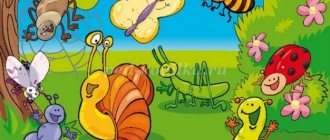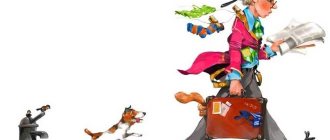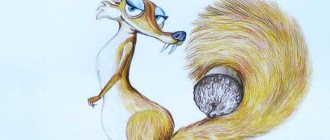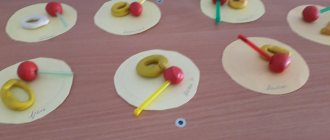Technological maps for designs of clothing, shoes and hats
The reference lines for clothing designs are straight lines intersecting at an angle and resembling letters.
Table: drawing diagrams of wardrobe elements for older preschoolers
| Theme of the drawing | Description |
| "Summer Wardrobe" | T-shirt
Shorts
Dress (blouse)
|
| "Cap" |
|
| "Dress for a doll" |
|
Photo gallery: samples of clothing patterns
If you make the dress shorter, you get a blouse, and if you lengthen the shorts, you get trousers
To draw woolen items you need to make soft transitions of elements
This dress is drawn based on a vertical line in the center of the image.
Photo gallery: templates for decorating and coloring clothes
Children can choose their own pattern for coloring the shirt
An additional task for coloring a dress can be a selection of decorative elements
Children with mental retardation can be given the task of coloring their skirt in a certain color, trying not to go beyond the boundaries of the image.
Based on this coloring book, children can come up with stories about where they have been and what fairy shoes they have seen.
You can use wax crayons to color the mittens.
While coloring a straw hat, children practice different types of shading
Video: master class on drawing winter hats
Video: master class on drawing shoes
Video: master class on drawing an elegant dress for a doll
Video: master class on drawing and painting a national costume
Drawing clothes, hats and shoes in the senior group gives children initial ideas about modeling wardrobe items and teaches them how to create original prints based on geometric patterns. Children improve their visual skills, practice the ability to use a brush and pencils to create images of varying degrees of color intensity, and expand their knowledge of the history of national costume. In addition, templates for drawing clothes are used in working with children with mental retardation.
Drawing up a summary of a drawing lesson on the topic “Clothes, shoes and hats”
According to the Federal State Educational Standard, a drawing lesson includes the following stages of working on the topic:
- introductory - up to 3 minutes - to motivate the guys,
- main - up to 20 minutes - for discussing the scheme of drawing and the visual activity itself, as well as for performing physical education and finger gymnastics,
- the final one - up to 2 minutes - to create an exhibition of drawings, evaluate the works by the teacher and reflect on the authors themselves.
Table: Mukhina T.A. Summary of a drawing lesson on the topic “Dress for a doll” in the senior group (fragments)
| Stage | Content |
| Introductory | Children sit in a semicircle on chairs on the carpet. The teacher suggests looking at two cups, one of which has a pattern and the other without a pattern. Educator: Guys, what is this? How are these cups different? Which cup do you think is more beautiful? — Guys, what do they use patterns for? (For decoration, to make it beautiful, to make the objects different and interesting) - Tell me, where did you see the pattern? (On clothes, on dishes, on the window in winter) - Look at your clothes, which of you has a pattern? Maybe you can find a pattern in our group? (Carpet, toy rack, dishes, tights, skirts, dresses)…>, |
| <,... - Today the doll Masha came to visit us and brought her outfits. Look, all her dresses are the same. How to make them different and beautiful? | |
| Basic | Educator: - Today I suggest you decorate a dress for a doll. To do this, I will give you dress blanks, and you will draw a pattern on them with colored pencils. — Think about what elements the pattern will consist of? What color will it be? |
| Educator: - Guys, sit down in your seats and get to work. If the child completed the task before others, he should be offered to paint another dress or another silhouette (scarf, headscarf, apron, etc.) A couple of minutes before the end of the main part, the teacher notifies the children. Educator: - Guys, our time is coming to an end, we need to finish our work. | |
| Final | Educator: - Guys, now it’s time to take the work to the “exhibition.” Let's place them here, near the doll. The teacher places the work next to the doll. The doll sits on the table, the children stand around the tables. Analysis of children's work Educator: - Guys, look carefully at your work. - What did you draw today? What elements did you use to decorate the doll’s dress? — What colors did you use for decoration? |
| Assessment of children's activities Educator: - Guys, the doll says thank you very much for the fact that now she has many different beautiful outfits. Well done! | |
| Quote from: https://nsportal.ru/detskiy-sad/risovanie/2018/05/13/konspekt-nod-po-dekorativnomu-risovaniyu-v-starshey-gruppe-na-temu | |
Clothing can be depicted separately, or as a character’s outfit in topics dedicated to depicting people, for example, “Heroes of your favorite fairy tales”



